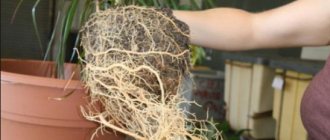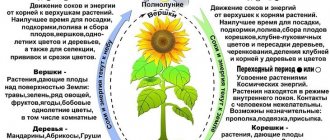October is golden autumn, leafy and wedding.
In October, the last plants that could still remain in the garden or on the balcony (such as aucuba, laurel, ligustrum, boxwood) are brought indoors. At this time, many indoor plants enter a state of winter dormancy. Therefore, they need to be watered much less frequently and not fed with anything until spring. In the middle or end of October, due to weather conditions, when the temperature remains stable at -5-8 C, they begin to cover the roses for the winter with spruce branches. If there are prerequisites for the onset of early severe frosts with a small amount of snow, then you can fill the central part of the rose bush with dry humus and compost, and you need to protect them from moisture, covering them so that air circulation is ensured under the cover, otherwise the roses may dry out.
Helpful advice. How to clean a clay pot from white limescale or stains? - Rub the pot with raw potatoes, and then rinse everything off in water with a stiff brush.
ATTENTION! Our gardener's lunar calendar is kept according to Moscow time . (The calendar can be used throughout Russia, taking into account the difference between Moscow and local time *
)
Moon calendar |
How the Moon affects indoor plants
The biorhythms of all plants directly depend on the rotation of the Earth around the Sun, leading to the change of day and night, and seasons. Indoor flowers are no exception. The cyclical nature of their life processes is also associated with the passage of the Moon through 12 zodiac signs per lunar month (29-30 days). Lunar energies influence the periods of growth and rest of plant organisms, the direction of movement of their juices, and the ability to accumulate nutrients.
Moon phases
As the Moon moves through its orbit, it illuminates the Earth in different ways. These periodically changing states of illumination are cyclical in nature and are called phases of the moon. A new moon is the position of the Moon when it is located on the same line between the Earth and the Sun. This is the time when our planet's satellite is not visible in the sky. During a full moon, the Moon appears as a full, luminous disk. Its influence on the life of plants is taken as a basis when compiling lunar calendars for indoor plants.
| Moon phase | influence on the plant |
| Waxing Crescent (first, second lunar phase) | There is a movement of juices from the roots to the leaves, flowers, and fruits. The period is characterized by high activity of green organisms and active growth. Nutrients are collected by its above-ground part. It is recommended to sow seeds, abundant watering, replanting crops, rooting cuttings, dividing the bush, and loosening the soil. |
| Full moon | Vital forces reach their maximum value. The plant organism has absorbed all the beneficial substances available to it. Planting long-germinating seeds is favorable. At this time, thinning, watering, mineral fertilizing, and spraying are well tolerated. |
| Waning moon (third, fourth lunar phase) | There is a gradual decline in vital activity, the level of cell fluid decreases, and there is an outflow of nutrients to the roots, accumulated during the process of photosynthesis. Rooting and preparation for forcing bulbs and tubers are favorable. Pruning is done to slow down growth. Spraying with drugs against diseases and pests is effective. It is recommended to limit watering. |
| New moon | All the power is concentrated in the root system, the body needs rest, it is preparing for a new cycle. During this period, it is not recommended to touch the plant. Any manipulation will negatively affect the condition of the flowers. A good day to fight diseases and pests. |
Zodiac signs
The moon, making its move across the sky, spends some time in one or another zodiac sign. Astrologers know about the lunar influence on the physiological processes of living organisms and compile lunar calendars for indoor plants. The Earth's satellite is in each of the 12 zodiac signs for 2-3 days, influencing in a certain way the biorhythms of living beings. Zodiac signs are distinguished:
- "Fertile." They are named so because crops planted or sown at this time grow quickly and produce high yields. These are: Cancer, Scorpio, Pisces, Taurus (partly) and Libra.
- "Barren". On days when the Moon is in these signs, you should not plant crops in floriculture and agriculture, or sow seeds. This is recorded in the lunar calendar for indoor plants. It is noted that seedlings will be “unfriendly” and painful when the Moon is under the influence of Leo, Sagittarius, Aries.
- Signs of average “fertility”: Capricorn, Virgo, Gemini, Aquarius.
For centuries, humanity has collected bit by bit information about the germination, development, growth, and fertility of plants. The lunar calendar indicates the position of the Moon in a particular zodiac constellation and its influence on crops grown by humans:
- Aries. Characterized by intensive growth of new shoots.
- Calf. The harvested crop during this period is stored for a long time without spoiling.
- Virgo. There is rapid germination and excellent survival rate of plants during transplantation.
- Scales. The pulp of the fruit is filled with juice, the flowers are especially fragrant these days, and the resistance to pests and diseases of the plant world is maximum.
- Scorpio guarantees cultivated crops planted during this period resistance to infections and long-term storage of fruits.
- Sagittarius promotes the formation of a large number of seeds and a long stem for sprouts planted in its days.
- Capricorn is rightfully considered a fertile sign. It gives an excellent harvest, resistance of plant organisms to frost, drought, and disease.
- Cancer promotes a bountiful harvest that does not store well. The seeds are of poor germination.
- Twins. The yield is not high, but has a long shelf life.
- Aquarius, Leo are good for collecting seeds.
- Fish. Agricultural crops planted on this day have high yields. Harvesting should not be planned for these days: the storage period is short, the fruits spoil quickly.
Moon in zodiac signs
The lunar disk passes through 12 zodiac signs, which influence the biorhythms of the night star. It is important for gardeners to know the following information:
- waning Moon in Scorpio and waxing in the sign of Capricorn - tubers and flower bulbs can be replanted;
- waning Moon in Cancer and growing in air signs, Scorpio and Pisces - you can replant decorative foliage plants;
- waning Moon in Sagittarius and Virgo, growing in Gemini - you can replant vines and hanging plant species.
Note! Favorable zodiac signs for working with plants are Scorpio, Taurus, Cancer, Libra, Capricorn and Pisces. Unfavorable signs are Aquarius and Leo.
If the moon passes through the constellation Aries, the plants do not perceive nutrients - fertilizing is useless.
The constellation Leo is also not favorable for applying fertilizers, watering plants and treating with pest control agents.
It is best to plant seedlings and sow seeds when the waxing moon passes through the constellation Virgo or the waning moon is in the constellations Cancer or Scorpio.
Pruning and pinching of branches is best done when the waning moon crosses the constellations Gemini or Aquarius.
Complete care for indoor plants in March 2022
Unfortunately, many novice gardeners have repeatedly noted the loss of a beautiful plant after winter. The reason for this is drafts, lack of daylight, dryness or waterlogging of the soil. Unknowingly, many beginners place fancy indoor plants on the windowsill, not forgetting about daily ventilation. A sharp change in climate negatively affects any plant, but is worst reflected on heat-loving crops that prefer a certain temperature. For example, Anthurium, a flower that personifies the masculine principle, should not only not be overcooled, but also not flooded or moved to different places. The plant prefers partial shade, excluding transfers around the room and flooding of the root system.
In the presence of additional lighting, a heated mat and a humidifier, in March they continue to use the supporting indicators necessary for a speedy exit from hibernation. Humidification is carried out twice a day, including home appliances for 20-35 minutes. It is allowed to add essential oils of Lavender, coniferous trees or grapefruit.
In order not to lose plants weakened after the winter months, it is recommended to follow six simple rules in March that are responsible for full development:
- Regular watering is carried out as the top layer of soil dries, using a small volume of liquid to avoid overwatering. If necessary, irrigation with warm water and shower procedures are allowed. After performing water manipulations, it is recommended to exclude drafts or hypothermia of plants when ventilating the room.
- At the beginning of spring, plants lack full sunlight. Daylight hours are not long. If possible, it is worth using phyto-lamps that promote the awakening of light-loving flowers and early budding.
- Warm mats are necessary if kept on cold surfaces. The window sill during the heating season does not need additional heating, but rather humidification due to lack of humidity.
- Fertilizing should be introduced gradually, using different fertilizers alternately. Mineral, organic and complex complementary foods are diluted according to the instructions, starting with 1/2 the dosage of the full volume.
- To prevent the plant from skewing in a certain direction, you need to turn the pot in different directions weekly, repeating the trick of flower shops. The secret helps to achieve an ideal “sales appearance”.
- Daily moistening using a special device or sprayer, in combination with loosening the top layer of soil, will retain moisture in the soil longer, promoting healthy color and elasticity of the leaves.
- Inspection of bulbous and tuberous plants for damage. After wintering, the procedure is necessary to prevent the formation of stains, pests, and rotting.
Florist's lunar calendar by month for 2022
The following are the phases of the Moon and the signs of the Zodiac in each month of 2022 and favorable and prohibited days for planting certain types of flowers.
Legend:
- ◑ — waning moon;
- ○ — Full Moon;
- ◐ — waxing Moon;
- ● — New Moon.
❄ January 2022
Moon phases in January 2022:
- ◑ — 1, 19-31.
- ● — 2 (21h 34m).
- ◐ — 3-17.
- ○ - 18 (02:48).
Days according to zodiac signs:
- ♐ Sagittarius - 1, 27 (from 10:34 a.m.)-29 (until 12:09 p.m.).
- ♑ Capricorn - 2, 3, 29 (from 12:09 a.m.)-31 (until 12:43 p.m.).
- ♒ Aquarius - 4, 5, 31 (from 12:43 pm).
- ♓ Pisces - 6, 7.
- ♈ Aries - 8-10 (until 17:48).
- ♉ Taurus - 10 (from 17:48)-12.
- ♊ Gemini - 13-15 (until 19:11).
- ♋ Cancer - 15 (from 19:11)-17.
- ♌ Leo - 18-20 (until 17:03).
- ♍ Virgo - 20 (until 17:03)-22.
- ♎ Libra - 23, 24.
- ♏ Scorpio - 25-27 (until 10:34 am).











